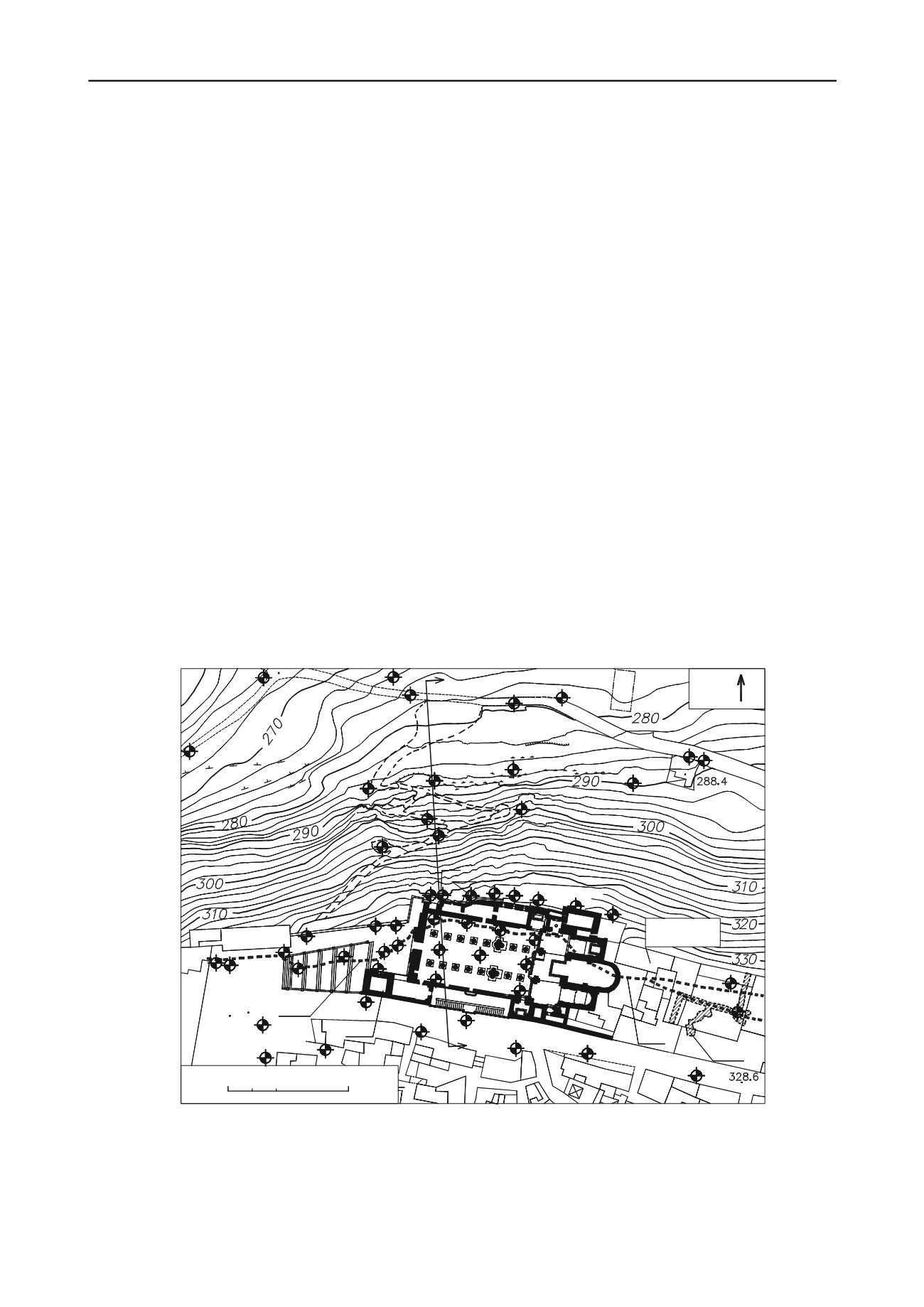
3142
Proceedings of the 18
th
International Conference on Soil Mechanics and Geotechnical Engineering, Paris 2013
Cathedral as well as on the adjacent northern slope;
(max depth of borings: 70m); 14 vibrating wire
piezometric cells, 1 Casagrande piezometer, 2 open
standpipe piezometers, and 7 inclinometer tubes were
installed. Piezometric and inclinometric readings
started in 2012 and are still carried out. Five
exploratory pits were also excavated in the Cathedral.
During the 2012 investigation campaign: SPT, Menard
pressurimeter and in situ permeability tests were carried out,
and many undisturbed samples were taken for laboratory
testing.
3 GROUND CONDITIONS
The Agrigento Hill is made up of layers of soils and soft
rocks belonging to the northern limb of an asymmetric
syncline with approximately E-W axis (Croce et al., 1980;
Cotecchia et al., 2005). The core of the syncline is known as
Agrigento Formation, AF, and dates back to Lower
Pleistocene; it overlies Monte Narbone Formation, MNF,
(Middle-Upper Pliocene). Within the area pertaining to the
Cathedral the following layers have been recognised from
bottom to top:
a) Grey, heavily overconsolidated clay with rare, thin lenses
of silty sand, A; this layer is about 200 m thick and belongs to
the MNF; its altered upper part A
contains gypsum veins.
b) Soft, reddish biocalcarenites interbedded with yellowish
calcarenitic sands, CLR. The thickness of this layer ranges
from 24 to 37m. The contact with the underlying clay is sharp
and dips approximately towards the South.
c) Grey clay AG, and grey-yellowish clay with thin
subvertical veins or spars of minute crystals of secondary
gypsum, AGG. The overall thickness of this layer (AG plus
AGG) is about 12m. The contact with the underlying
calcarenites is clearly defined by a thin transition layer, made
up of clay intermingled with carbonatic shell shreds, and
dipping 15-18° towars the South.
d) Silty sand and sandy silt, from grey to yellowish, SL. The
thickness of this layer ranges from 4 to 6m.
e) Soft yellowish or reddish calcarenite interbedded with
yellowish silty sand, CL. The rocks are frequently fractured.
The thickness of this layer ranges from 4 to 12m. Small
cavities have been found in these rocks in which an unlined
passable adit has been excavated many years ago (Ismani
hypogeum in Fig. 1).
Soil and rock b, c, d, e belong to AF.
A schematic vertical profile of the ground is shown in Fig.
2. It may be noted that the various layers bend down when
approaching the slope. Similar ground conditions have been
ascertained within the zone relevant to the Cathedral.
4 GEOTHECNICAL PROPERTIES OF SOILS AND
ROCKS
Some data derived from results of laboratory and in situ
tests are summarised in tables 1 and 2.
5 POREWATER PRESSURES
The few available piezometric data point out to the
existence of a perched groundwater table within the fine-
grained soils overlying calcarenites CLR. This hypothesis is
consistent with the high permeability coefficient of
calcarenites CLR and CL and with the observation that
drilling water was systematically lost when boring in these
rocks. A tentative groundwater table is drawn in Fig. 2.
Fig. 1. Schematic plan of the Cathedral and of the adjacent slope, and location of the most relevant borings. It is also shown the longitudinal fracture
or tension crack running through the northern aisle, the archiepiscopal palace and the Ismani hypogeum on the East side, and through the parvis and
Don Minzoni square on the West side. Borings S201-S227 drilled in 2012; borings S12-S29 drilled in 2008; borings S1*-S9* drilled in 2005.
Boreholes equipped with inclinometer tube: S1*, S2*, S3*, S4*; S13, S16, S20, S22, S26, S29; S203, S204, S207, S208, S209, S220, S221.
6 FOUNDATIONS OF THE CATHEDRAL
The columns and the southern wall have been founded
directly on, or slightly above, the top surface of calcarenites
Don Minzoni
square
S26
S22
S6
0 10 20
50m
S4
S13
S16
S3
S17
S20
S1
S2
S219
S204b
S204
S225
S221
S222
S220
S201b
S202b
Ex Museum
S227
S214
S212
S211
Hypogeum
S216
S209
S208
S203
S207
S19b
S19
Duomo street
N
S217
S218
S215
S213
S210
S206 S206b
S205b
S205
S205ter
S222b
S223
S224
B'
B
S15
S12
S29
S28
S23
Tension
266.8
317.0
Archiepiscopal
Palace
crack
Tension
crack
Bell
tower
Ismani
*
*
*
*
*
S18
S14
S21
S25
S9
*
S27


